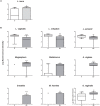Insights Into Vaginal Bacterial Communities and Metabolic Profiles of Chlamydia trachomatis Infection: Positioning Between Eubiosis and Dysbiosis
- PMID: 29643849
- PMCID: PMC5883401
- DOI: 10.3389/fmicb.2018.00600
Insights Into Vaginal Bacterial Communities and Metabolic Profiles of Chlamydia trachomatis Infection: Positioning Between Eubiosis and Dysbiosis
Abstract
The vaginal microbiota plays a crucial role in maintaining the health and functioning of the female genital tract, preventing the colonization of urogenital pathogens and sexually transmitted infections. In this study, we characterized the vaginal bacterial communities and the metabolome associated to Chlamydia trachomatis infection (CT: 20 women), compared to healthy condition (H: 22 women) and bacterial vaginosis (BV: 19 women). A microarray-based tool (VaginArray), implemented with a real-time PCR for Gardnerella vaginalis, was used to determine the vaginal bacterial composition, whereas the metabolic profiles were assessed by a proton-based nuclear magnetic resonance (1H-NMR) spectroscopy. CT infection was characterized by bacterial and metabolic signatures similar to healthy condition, even though higher amounts of Lactobacillus iners, as well as depletion of some amino acids, biogenic amines, and succinate marked CT infection. Moreover, the frequency of Lactobacillus crispatus was higher in asymptomatic CT-positive patients than in women with CT-correlated symptoms. We also confirmed the marked differences in the microbiome and metabolome between healthy and BV-affected women. In conclusion, we highlighted microbial and metabolic peculiarities of the vaginal ecosystem in the case of CT infection, even though further studies are needed to understand if the observed alterations precede the infection onset or if the pathogen itself perturbs the vaginal environment.
Keywords: Chlamydia trachomatis; bacterial vaginosis; eubiosis; vaginal metabolome; vaginal microbiota.
Figures




Similar articles
-
Diversity of vaginal microbiome and metabolome during genital infections.Sci Rep. 2019 Oct 1;9(1):14095. doi: 10.1038/s41598-019-50410-x. Sci Rep. 2019. PMID: 31575935 Free PMC article.
-
Metagenomic Shotgun Sequencing of Endocervical, Vaginal, and Rectal Samples among Fijian Women with and without Chlamydia trachomatis Reveals Disparate Microbial Populations and Function across Anatomic Sites: a Pilot Study.Microbiol Spectr. 2022 Jun 29;10(3):e0010522. doi: 10.1128/spectrum.00105-22. Epub 2022 May 17. Microbiol Spectr. 2022. PMID: 35579443 Free PMC article.
-
Alterations of Vaginal Microbiota in Women With Infertility and Chlamydia trachomatis Infection.Front Cell Infect Microbiol. 2021 Aug 3;11:698840. doi: 10.3389/fcimb.2021.698840. eCollection 2021. Front Cell Infect Microbiol. 2021. PMID: 34414130 Free PMC article.
-
The two-sided role of the vaginal microbiome in Chlamydia trachomatis and Mycoplasma genitalium pathogenesis.J Reprod Immunol. 2018 Nov;130:11-17. doi: 10.1016/j.jri.2018.08.006. Epub 2018 Aug 22. J Reprod Immunol. 2018. PMID: 30149363 Review.
-
Vaginal microbiome.Ceska Gynekol. 2018 Winter;83(5):371-379. Ceska Gynekol. 2018. PMID: 30848142 Review. English.
Cited by
-
Distribution of ermB, ermF, tet(W), and tet(M) Resistance Genes in the Vaginal Ecosystem of Women during Pregnancy and Puerperium.Pathogens. 2021 Nov 26;10(12):1546. doi: 10.3390/pathogens10121546. Pathogens. 2021. PMID: 34959501 Free PMC article.
-
Complex species and strain ecology of the vaginal microbiome from pregnancy to postpartum and association with preterm birth.Med. 2021 Sep 10;2(9):1027-1049. doi: 10.1016/j.medj.2021.06.001. Epub 2021 Jul 1. Med. 2021. PMID: 34617072 Free PMC article.
-
Influence of cervicovaginal microbiota on Chlamydia trachomatis infection dynamics.Microb Cell. 2025 Apr 15;12:93-108. doi: 10.15698/mic2025.04.848. eCollection 2025. Microb Cell. 2025. PMID: 40309355 Free PMC article. Review.
-
The Correlation between Chlamydia Trachomatis and Female Infertility: A Systematic Review.Rev Bras Ginecol Obstet. 2022 Jun;44(6):614-620. doi: 10.1055/s-0042-1748023. Epub 2022 May 16. Rev Bras Ginecol Obstet. 2022. PMID: 35576969 Free PMC article.
-
Molecular Mechanism of Microbiota Metabolites in Preterm Birth: Pathological and Therapeutic Insights.Int J Mol Sci. 2021 Jul 29;22(15):8145. doi: 10.3390/ijms22158145. Int J Mol Sci. 2021. PMID: 34360908 Free PMC article. Review.
References
-
- Aiyar A., Quayle A. J., Buckner L. R., Sherchand S. P., Chang T. L., Zea A. H., et al. (2014). Influence of the tryptophan-indole-IFNγ axis on human genital Chlamydia trachomatis infection: role of vaginal co-infections. Front. Cell. Infect. Microbiol. 4:72 10.3389/fcimb.2014.00072 - DOI - PMC - PubMed
-
- Borgdorff H., Tsivtsivadze E., Verhelst R., Marzorati M., Jurriaans S., Ndayisaba G. F., et al. (2014). Lactobacillus-dominated cervicovaginal microbiota associated with reduced HIV/STI prevalence and genital HIV viral load in African women. ISME J. 8 1781–1793. 10.1038/ismej.2014.26 - DOI - PMC - PubMed
LinkOut - more resources
Full Text Sources
Other Literature Sources

